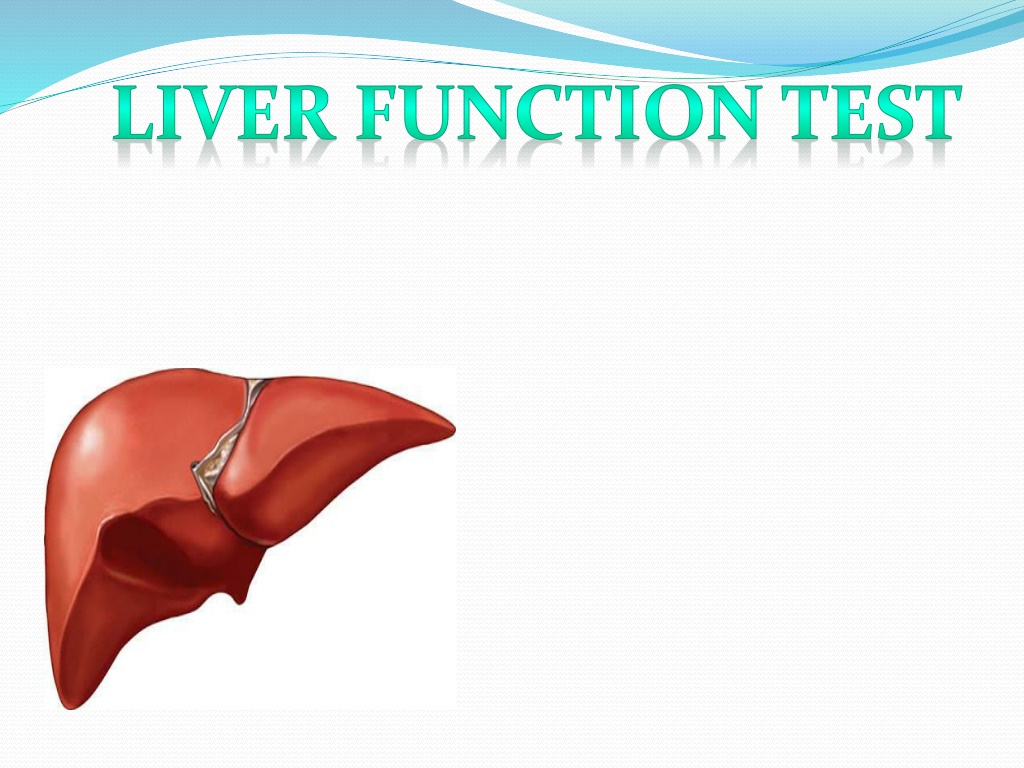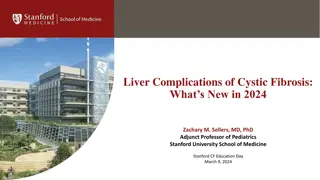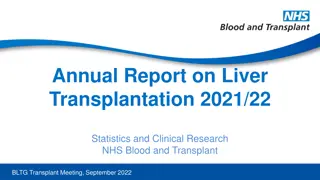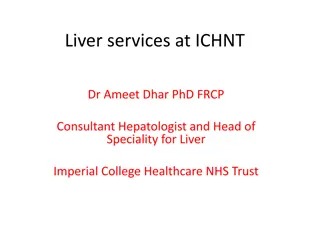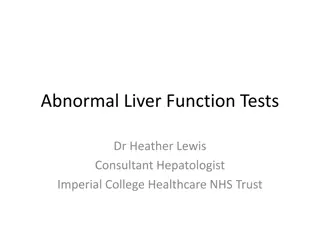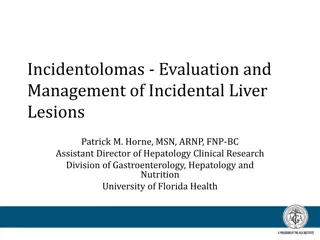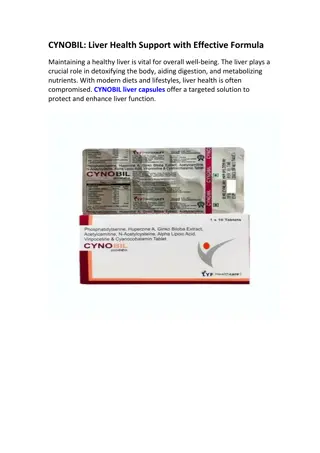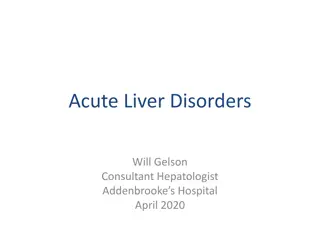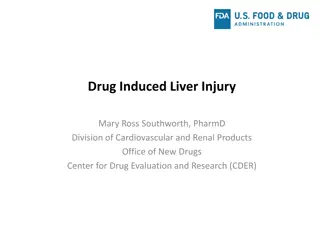Understanding Liver Function Tests and Their Significance
The liver carries out essential metabolic, excretory, protective, synthetic, and storage functions in the body. Liver function tests play a crucial role in screening for liver dysfunction, recognizing patterns of liver disease, assessing patient prognosis, monitoring disease progression, and evaluating therapy responses. These tests measure various enzymes, proteins, and substances in the blood that indicate liver health and function. Elevated levels of certain markers like SGPT (ALT) can point to liver issues such as viral hepatitis, diabetes, or liver damage. Other tests like blood ammonia and AFP are also used to assess liver health. Understanding the significance and interpretation of liver function test results is key in diagnosing and managing a range of liver conditions.
Download Presentation

Please find below an Image/Link to download the presentation.
The content on the website is provided AS IS for your information and personal use only. It may not be sold, licensed, or shared on other websites without obtaining consent from the author. Download presentation by click this link. If you encounter any issues during the download, it is possible that the publisher has removed the file from their server.
E N D
Presentation Transcript
Function of Liver 1.Metabolic Functions: Urea cycle Glycogen synthesis Vitamin Metabolism Minral Metabolism Lipid Metabolism Glycolysis 2.Excretory Functions: Cholesterol Bile Pigments Bile salts 3.Protective Functions & detoxification: Ammonia Clearance of insulin, PTH, estrogens, cortisol.
4.Hematological function: Formation of Blood Destruction of erythrocytes 5. Synthetic functions: Protein, Albumin, Prothrombin, Hormones 6.Storage Functions: Glycogen, Vitamin A, D and B12
USES Screening of liver dysfunction To recognize Pattern of liver disease To Assess Prognosis of patient Follow up of disease To evaluate the response to therapy
Liver function tests include: SGPT (ALT-Alkaline Transaminase) SGOT (AST-Aspartate Transaminase) GGT (Gama glutamic traspeptidase) ALP (Alkaline Phosphatase) Bilirubin Total Protein Serum Albumin Serum Globulin PT/BT /CT (Prothombin, Bledding, Clotting Time) 5 nucleotide
Other test include: Blood ammonia LDH (Lactate Dehydrate) AFP (Alfa feto protein) Ceruloplasmin Leucine aminopeptidase Alpha - 1 antitrypsin Procollagen III peptide Cholesterol Glycoprotein
SGPT(ALT) Method: L- Alanine LDH UV Kinetic (IFCC kinetic) Measuring the rate of decrease in absorbance of NADH at 340 nm due to the oxidation of NADH to NAD.
Significance Serum Glutamic Pyruvate Transaminase (SGPT) Alanine aminotransferase (ALT) Enzyme present in hepatocytes . Significantly elevated levels of ALT (SGPT) often suggest the existence of other medical problems such as viral hepatitis, diabetes, congestive heart failure, liver damage, bile duct problems, infectious mononucleosis, or myopathy. So ALT is commonly used as a way of screening for liver problems.
INERFARANCE: Alanine transaminase (ALT) 10-40 u/L When a cell is damaged, it leaks this enzyme into the blood, where it is measured. ALT rises in Viral hepatitis Alcoholic Liver disease Hepatic congestion Hepatocellular carcinoma Cholecystitis Paracetamol (acetaminophen) overdose.
SGOT (AST) Principal Method: L- Alanine LDH UV Kinetic SGOT (AST) catalyzes the transfer of amino group between L-Aspartate and Ketoglutarate to form Oxaloacetate and Glutamate. The Oxaloacetate formed reacts with NADH in the presence of Malate Dehydrogenase to form NAD. The rate of oxidation of NADH to NAD is measured as a decrease in absorbance which is proportional to the SGOT (AST) activity in the sample.
L-Aspartate + Ketoglutarate SGOT Oxaloacetate + L-Glutamate
Significance Serum Glutamic Oxaloacetic Transaminase (SGOT) The AST is a cellular enzyme is found in highes concentration in heart muscle, The cells of the liver the cells of the skeletal muscle & in smaller amounts in other weaves. The blood SGOT levels are thus elevated with liver damage or insult to the heart. Some medication can also raise SGOT level.
Interference Normal Range:- 10-40 U/L It is raised in acute liver damage, But,also present Red blood cells Cardiac and Skeletal muscle And therefore it is not specific to the liver.
GGT PRINCIPAL Method: Carboxy Substrate Method GGT catalyzes the transfer of amino group between L- -Glutamyl-3-carboxy-4 nitroanilide and Glycylglycine to form L- -Glutamylglycylglycine and 5-amino-2- nitrobenzoate. The rate of formation of 5-amino-2-nitrobenzoate is measured as an increase in absorbance which is proportional to the GGT acitivity in the sample.
L- -Glutamyl 3-carboxy 4-nitroanilide + Glycylglycine GGT L- -Glutamyl glycylglycine+ 5-Amino-2- nitrobenzoate.
Significance The gamma-glutamyl transferase (GGT) test may be used to determine the cause of elevated alkaline phosphatase (ALP). Both ALP and GGT are elevated in disease of the bile ducts and in some liver diseases.
Interference Normal Range: 10-30 u/L. Although reasonably specific to the liver and a more sensitive marker for cholestatic damage than ALP. Gamma glutamyl transpeptidase (GGT) may be elevated with even minor, sub-clinical levels of liver dysfunction. GGT is raised in alcohol toxicity (acute and chronic).
ALP PRINCIPAL Method: para-nitrophenylphosphate with AMP buffer Alkaline phosphatase in the sample catalyzes the hydrolysis of colourless p-nitrophenyl phosphate (p-NPP) to give p-nitrophenol and inorganic phosphate. At the pH of the of the assay (alkaline), the p- nitrophenol is in the yellow phenoxide form. The rate of absorbance increase at 404 nm is directly proportional to the alkaline phosphatase activity in the sample. Optimized concentrations of zinc and magnesium ions are present to activate the ALP in the sample.
CLINICAL SIGNIFICANCE Increased levels of serum ALP; In growing children Bone disease like; Metastasis, rickets, healing fractures, Osteomalacia. Sex Age Reference Interval Male-femals 4-15 yr 54-36 U/L Male 20-50 yr 53-128 U/L Male >60 yr 56-119 U/L femals 20-50 yr 42-98 U/L femals >60 yr 53-141 U/L
Interference Mild elevations (<500 IU/L) Viral hepatitis Alcoholic cirrhosis Infiltrative liver disease like lymphoma, sarcoidosis Moderate elevation (500 1000 IU/L) Cholecystitic Gall bladder stone Severely elevation (>1500 IU/L) Osteomalacia Osteoporosis Ricket Osteosarcoma Bone tumour Paget's disease
Bilirubin PRINCIPAL Method: Diazo Reaction Bilirubin glucuronide +diazonium salt azodye (tan or pink to viotel)
Different between Unconjugated & Conjugated Bilirubin UNCONJUGATED CONJUGATED Insoluble Soluble <1.3 In water In alcohol Normal Soluble Soluble <0.4 Present Normally absent Not absorbed In bile In Urine Absorption gut Absent Always absent Absorbed Diffuses-yellow colour Indirect + Diffusion into tissues Van den bergh Doesn t diffuse Direct +
Type & Cause of Jaundice Pre-hepatic Jaundice Intra-Hepatic Jaundice Neonatal (Physiological) Jaundice Acute Viral hepatitis Alcohol Cirrhosis Malaria Cirrhosis of Liver G 6 PD deficiency Primray Biliary Cirrhosis, Thalassaemia Haemochromatosis Sickle cell disease Wilson Disease Mis-match Blood Transfusion Alpha-1 antitrypsin deficiency Drug induce Quinine Group, NSAID, Chemotherapeutic drugs Auto-immune Post Hepatic Jaundice Gall Bladder - Common Bile Duct - Pancreatic duct Stone Gall Bladder - Hepatic Pancreatic Duodenal Carcinoma
PHYSIOLOGIC JAUNDICE OF THE NEWBORN
Heamolytic Obstructive r Blood Examination Total Billirubin Direct Billirubin Indirect Billirubin Normal Normal ALT Normal Normal Alkaline phosphatase Normal / Normal Urine Examination Normal Normal / Bile Pigment Urobillinogen Normal / Absent Absent Normal Normal / Bile Salt Stool Examination Specific Investigation Normal Normal Clay Colour 31 Haemoglobin, LDH Liver Function Test USG Abdomen
Van den bergh Test :Direct & Indirect Bilirubin Method: Diazo Reaction This is specific reaction to identify the increase in serum bilirubin level. Normal serum gives a negative Van den Bergh reaction. sulfanilic acid + sodium nitrate Diazotized Diazotized sulfanilic acid + bilirubin Azobilirubin (purple color).
Give major causes for increase in blood Bilirubin level:- Major causes for increase bilirubin levels in blood: Hemolysis:- Damage to RBC may cause increased breakdown of Hb producing Unconjugated Bilirubin, which may overload liver conjugating system, causing Hyperbilirubinemia; Failure of Conjugating system in the liver, Obstruction in the Biliary system,
Total Protein PRINCIPAL Method: Biuret Proteins react with cupric ions in alkaline medium to form a violet colored complex. The intensity of the color produced is directly proportional to proteins present in the specimen and can be measured on a photometer at 530 nm (or by using a green filter). Normal Range Serum Protein: 6-8 g/dl
Albumin Principal Method: Bromocresol Green (BCG) Albumin present in serum binds specifically with bromocresol green at pH 4.1 to form green colored complex, intensity of which can be measured colorimetrically by using 640 nm (or a red filter) Normal Range 3.3-4.8 g/dl
Total Protein & Albumin Both decrease in Hepato-cellular disease. Because it is synthesized & store into liver. It may found decrease in following disease: Malnutrition Chronic disease Nephrotic syndrome Inflammatory bowel disease Chronic infection Tuberculosis
Prothombin time Principal Method: Capillary tube method When preformed tissue thromboplastin and calcium chloride are added to citrated plasma, the plasma clots. The time taken for the clot to appear is called Prothrombin time (PT).
Significance Prothrombin time (PT) is a blood test that measures how long it takes blood to clot. A prothrombin time test can be used to check for bleeding problems. PT is also used to check whether medicine to prevent blood clots is working. A PT test may also be called an INR test. Normal Range 11 to 16 second
Interferance Another measure of hepatic synthetic function is the prothrombin time. Prothrombin time is affected by proteins synthesized by the liver. Thus, in patients who have prolonged prothrombin times, liver disease may be present. Since a prolonged PT is not a specific test for liver disease, confirmation of other abnormal liver tests is essential.
Diseases such as malnutrition, in which decreased vitamin K ingestion is present, may result in a prolonged PT time. An indirect test of hepatic synthetic function includes administration of vitamin K (10mg) subcutaneously over three days. Several days later, the prothrombin time may be measured. If the prothrombin time becomes normal, then hepatic synthetic function is intact. This test does not indicate that there is no liver disease, but is suggestive that malnutrition may coexist with (or without) liver disease.
Bledding Time Determination of bleeding time helps to detect vascular defect & platelet disorder. Prolonged bleeding time is generally absociated thrombocytopenia. Principle:- A 1mm deep prick made on ear lobe or finger of the patient the length of time required for bleeding to cease is record. Normal Range:- 1-5 minutes
Procedure Sterilize the finger lip or ear lobe with spirit and given a deep prick to get free flow of blood, immediately, with a clean, white filter paper and note the time. Continue to apply the filter paper to pricked site at the interval 30 seconds, till no blood stain is seen on the filter paper. The duration of time from the firs sport till no blood stain on filter paper is known as BLEEDING TIME.
Clotting Time Principle:- Blood is collected in capillary tube after a finger prick & the stop watch is started. The formation of fibrin string is noted by breaking the capillary tube at regular interval, The time is noted at the first appearance of the fibrin string. This method is generally useful in severe clotting disorders. Normal Range:- 4-9 min.
Procedure Sterilize the finger top with spirit and given a deep prick to get free flow of blood. Start the stop watch as soon as blood starts coming out. Fill a thin capillary tube (it will be filled by capillary action by just applying the tip on the blood drop) with blood. After every 30 seconds, break a small portion of the capillary tube till a thin line of unbroken coagulam is seen between the broken ends. Stop the stop watch and note the time. This is CLOTTING TIME.
Blood Ammonia Ammonia is a by product of amino acid catabolism. Ammonia is used as a potential marker of hepatic encephaophathy, but it is not a good test for liver function. High annonia levels have been found with near normal liver function and vice versa.
Roll of liver Liver converts blood ammonia into urea and muscles use it in transmination reaction to produce glutamate or alanine etc.. Pateints with advanced liver diseases usually also have muscle wasting which then also contributes, to hyperammonemia. Liver biopsy is oftern the last test used to arrive at a final diagnosis of liver disease. It is indicated in chronic cases of liver diseases characterized by unexplained clinical findings pointing to liver disease.
Coagulation tests The liver is responsible for the production of coagulation factors. If it is increased, it means it is taking longer than usual for blood to clot. It will only be increased if the liver is so damaged that synthesis of vitamin K-dependent coagulation factors has been impaired. It is not a sensitive measure of liver function.
Hepatic neoplasm markers Alpha fetoprotein (AFP): primary hepatocellular carcinoma Carcinoembryonic antigen (CEA): increased CEA: liver metastatic carcinoma or other carcinomas of the gastrointestinal system Abnormal prothrombin (APT): increased APT primary hepatocellular carcinoma
